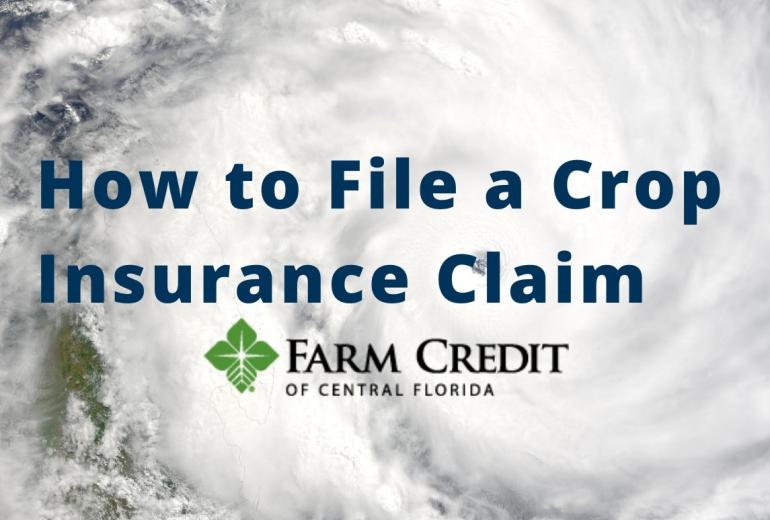How to File a Crop Insurance Claim

Qué hacer.
Qué no hacer.
¿Cómo inicio una reclamación?
Llame a su agente de seguros de cultivos y haga un seguimiento por escrito o por correo electrónico (conserve una copia para sus registros). Su compañía de seguro de cultivos hará los arreglos necesarios para que un perito en pérdidas inspeccione su cultivo. Es su responsabilidad llamar a su agente de seguros de cultivos e iniciar este proceso.
¿Cómo sé cuándo presentar una reclamación?
Daños en el cultivo
Cada vez que tenga daños en el cultivo que afecten negativamente su rendimiento o el valor del cultivo, usted puede ser elegible para presentar una reclamación. El perito en pérdidas determinará si su rendimiento es inferior al de la garantía de rendimiento establecida en su póliza de seguro de cultivos. Esto se aplica a las políticas de garantía de ingresos, así como a las políticas tradicionales de protección de rendimiento.
La mayoría de las pólizas establecen que usted (el asegurado) debe notificar a su agente dentro de las 72 horas posteriores al descubrimiento de los daños en el cultivo. Como cuestión práctica, siempre debe comunicarse con su agente de inmediato cuando descubra daños en el cultivo. En algunos casos, es posible que descubra una pérdida mientras está cosechando (un cultivo en surcos, por ejemplo). Deje de cosechar y comuníquese con su agente de inmediato.
En el caso de que las pérdidas se hayan descubierto después de la cosecha, debe presentar una notificación inmediatamente después de haber cosechado cada unidad (dentro de los 15 días) y antes del final del período del seguro.
Fin del marketing
Para los cultivos con historial de producción promedio (Average Production History, APH) como los arándanos, se debe presentar una reclamación para evaluar (verificar y valorar) el producto restante en el campo al final de la temporada de comercialización para usar el resultado en el historial de producción el año siguiente.
¿Qué tan pronto debo esperar un perito?
En la práctica, existen diferentes niveles de urgencia para los inspectores de cultivos.
Si aún se encuentra dentro del período de oportunidad para volver a plantar su cultivo o cambiarse a otro cultivo, comuníquese de inmediato con su agente de seguros de cultivos.
La compañía de seguros debe hacer todo lo posible por conseguir un perito de inmediato.
Si, por ejemplo, más adelante en la temporada de cultivo, un huracán elimina su cultivo o si una sequía grave daña su cultivo, aún debe comunicarse con su agente, pero la urgencia de una inspección depende de sus intenciones.
Si desea destruir el cultivo (tal vez para plantar un cultivo de cobertura), entonces un perito debe salir primero, antes de que usted haga cualquier cosa. Si, por otro lado, tiene la intención de continuar cuidando el cultivo y cosechando lo que pueda, hay menos urgencia para que el perito realice la inspección de inmediato. Aun así, se debe realizar una evaluación de los daños tan pronto como sea posible.
Mientras espera al perito, recuerde estas reglas: No destruya ninguno de sus cultivos. No pase una rastra de discos. No pase un arado. No vuelva a plantar. No haga nada para destruir su cultivo hasta que tenga el permiso de un perito tasador de reclamaciones o de un representante de la compañía de seguros.
Recuerde: No destruya la evidencia.
¿Qué debo esperar del perito?
El perito debe comunicarse con usted para programar una inspección. Esta persona esperará y aceptará que usted esté presente y que ayude durante la inspección. El perito estará interesado en lo que usted opina.
Puede esperar que el perito esté familiarizado con su póliza y le explique sus opciones.
Debe tener sus registros de producción o cosecha listos para mostrar la cantidad de acres y ubicaciones de sus cultivos asegurados.
El perito debe tener copias de los documentos de su póliza de seguro de cultivos y su historial de producción real (APH).
¿Cómo se calcula el rendimiento de mi cultivo?
Para algunos cultivos, contar las plantas dentro de un área de muestra en varias ubicaciones del campo es parte del proceso. En el caso de otros cultivos, determinar las libras de arándanos por arbusto es parte del proceso.
Es posible que los peritos tomen fotografías de los campos. Pueden consultar con sus vecinos sobre el estado de sus cultivos y pueden consultar con el corredor local para obtener rendimientos promedio del área. Incluso pueden consultar los datos meteorológicos locales.
El cálculo del rendimiento del cultivo no se trata de hacer conjeturas. Se trata de un proceso disciplinado. Su perito tiene una amplia capacitación en el aula y en el campo, y estudia constantemente para mantener su certificación.
Sus responsabilidades:
Informe de inmediato los daños en los cultivos:
• Antes de la replantación (muchas pólizas tienen pagos de replantación).
• Dentro de las 72 horas posteriores al descubrimiento de los daños.
• 15 días antes de que comience la cosecha (si existe la posibilidad de pérdida).
• Dentro de los 15 días posteriores a la finalización de la cosecha (por unidad de seguro) o al final del período del seguro.
Precaución: No destruya la evidencia necesaria para respaldar su reclamación sin haber recibido instrucciones claras de la compañía de seguros, preferentemente por escrito.
Agencia de Administración de Riesgos del Departamento de Agricultura de Estados Unidos
Fuentes:
Cómo reclamar un seguro de cultivos
Proceso de reclamaciones